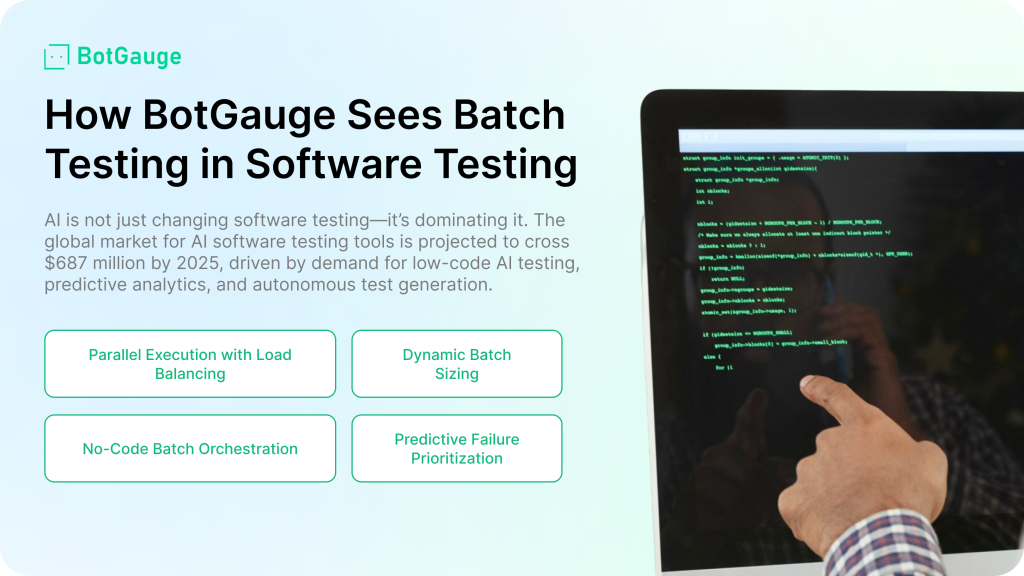Anyone can automate end-to-end tests!
Our AI Test Agent enables anyone who can read and write English to become an automation engineer in less than an hour.

Batch testing in software testing? How do we use AI to make it better? The global market for AI software testing tools is projected to cross $687 million by 2025, driven by demand for low-code AI testing, predictive analytics, and autonomous test generation.
Enterprises are ditching manual processes that waste hours fixing flaky tests and chasing false positives. With AI-powered QA, teams now fix bugs faster, cut costs by over 50%, and move closer to defect-free delivery. Ready to see what 2025 looks like?
BotGauge takes batch testing in software testing into a new level using smart automation techniques. First, it applies dynamic batching—inspired by research showing up to 99% compute reduction—automatically resizing test groups based on code deltas and available resources.
Next, our system uses predictive failure analytics: ML models forecast tests likely to break, so high-risk ones run first, speeding feedback. We run parallel batch testing across distributed CI/CD agents and use load balancing to cut build times significantly .
Finally, QA teams get a no-code batch testing dashboard that allows visual setup of batch flows, thresholds, and orchestrations without code. Combining continuous batch testing with AI-driven strategy makes BotGauge efficient, adaptive, and easy to use for fast-paced development cycles.
Batch testing in software testing plays a crucial role in modern automated software testing setups. Here’s why it matters:
Executing tests as parallel batch testing speeds up pipelines by reducing total runtime. Fast feedback allows developers to catch issues sooner—critical for continuous delivery in CI/CD workflows.
Dynamic batching trims resource wasted on redundant tests. Research shows Dynamic Batching can save up to 91% of test machines while maintaining feedback speed . That saves compute cycles and trims costs significantly.
Batch-level analytics track unstable tests across cycles. Flagging these early helps avoid false failures and keeps pipelines healthy.
AI-driven diagnostics highlight failure trends and coverage gaps. Teams isolate problematic tests and fix root causes instead of rerunning full batches—leading to optimized test suite optimization and efficient batch failure diagnostic processes .
BotGauge packs powerful tools to boost batch testing in software testing through intelligent automation and analytics:
BotGauge adjusts batch sizes based on code changes and agent availability. Research shows DynamicBatching cuts machine usage by up to 91% while keeping fast feedback intact. This CI/CD batch execution optimization minimizes redundant runs and tailors batch sizes to current needs.
Tests run concurrently across multiple CI agents. BotGauge’s orchestration balances the load, reducing queue time and speeding overall test cycles—much like distributed execution techniques used in large-scale CI environments.
Using models inspired by Facebook’s predictive test selection, BotGauge forecasts which tests are likely to fail first, improving defect detection speed and CI efficiency. These machine‑learning test scheduling methods help accelerate feedback.
Comprehensive dashboards display failure trends, flaky-test scores, coverage heatmaps, and performance metrics. These batch failure diagnostic tools make it easy to spot test degradation and focus maintenance efforts.
A visual editor lets QA teams configure batch flow, thresholds, and sequences without writing scripts. This no-code batch testing feature empowers non-technical users to manage batch strategies visually and intuitively.
Together, these features—dynamic batching, parallel batch testing, adaptive test batching, and test feedback acceleration—help teams work faster, more reliably, and with fewer resources.
Following proven CI/CD best practices and AI insights, here’s how to bring batch testing in software testing to life with BotGauge:
Install the BotGauge agent in your Jenkins, GitLab CI, or GitHub Actions pipeline. Run full test suites to gather metrics on runtime, failure frequency, and resource use. These establish your baseline performance.
Activate the dynamic batching logic. BotGauge groups tests dynamically—leveraging research showing up to 91% machine reduction while maintaining feedback time. Watch how batch sizes adjust based on code change size and agent availability.
Upload historical test results so BotGauge can train machine‑learning test scheduling models. This predictive failure prioritization mirrors Facebook’s and Gradle Develocity’s methods, catching over 95% of failures while halving resource use.
Use dashboards to track batch diagnostics, flaky test scores, and heatmaps. Adjust thresholds or quarantine unstable tests. Apply continuous refinements to optimize CI/CD batch execution and batch test orchestration.
With this phased rollout, BotGauge transforms testing pipelines into efficient, adaptive, and transparent workflows.
Using BotGauge boosts ROI by combining speed, efficiency, and reliability gains:
BotGauge redefines batch testing in software testing for today’s fast-paced, automated software testing environments. By combining dynamic batching, predictive failure models, continuous batch testing, and a visual, no-code batch testing interface, BotGauge transforms pipelines into resource-efficient, intelligent workflows. Teams gain faster feedback, better test stability, and lowered infrastructure costs while freeing QA to focus on quality, not maintenance. This modern approach positions your organization for faster releases and smarter testing.
AI adjusts group size based on test runtime and change scale—not a fixed engineer-set cluster.
Yes—BotGauge offers a visual, no-code batch testing dashboard that lets QA teams configure flows without writing code.
Yes—tests likely to fail run first, so you catch defects earlier and save CI pipeline minutes with machine‑learning test scheduling.
Batch-level analytics flag tests with inconsistent results over time—letting you quarantine or fix flaky ones before they disrupt pipelines.
Absolutely—designed for modern CI/CD platforms, it supports Docker, Kubernetes, distributed agents, and fully embraces CI/CD batch execution.
Curious and love research-backed takes on Culture? This newsletter's for you.
View all Blogs
Our AI Test Agent enables anyone who can read and write English to become an automation engineer in less than an hour.